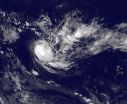(Press-News.org) Animal scientists in Brazil have found that a small dose of the feed additive ractopamine can boost pork production without changing how pork looks or tastes.
In the latest issue of the Journal of Animal Science, researchers report that a 5 mg/kg dose of ractopamine increased muscle mass and feed efficiency, and had no noticeable effect on pork marbling, fat content, toughness or color. The researchers came to this conclusion by testing pork from 340 pigs raised under commercial conditions.
"We found that if [pork producers] use 5 mg/kg of ractopamine in the finishing diet of swine that should result in no detrimental effects on fresh pork quality and cooked pork palatability," said Natália Bortoleto Athayde, an animal scientist at Sao Paulo State University in Brazil.
Ractopamine is a common feed additive in Brazilian and U.S. pork production. The additive increases the size of muscle fibers by increasing protein synthesis in muscle cells. Many pork producers use ractopamine because it allows pigs to grow larger with less feed.
However, some scientists have reported reduced pork quality with higher doses of ractopamine. To test this finding, Athayde and other researchers split a herd of pigs into three groups and gave them 0, 5 or 10 mg/kg of ractopamine during the last 28 days before slaughter. They then slaughtered the pigs and tested the pork pH, temperature, color, drip loss, marbling, intramuscular fat, cooking loss and tenderness. According to Athayde, analyzing meat color is important because meat color changes can be a sign of stress in an animal.
The researchers found that though 5 mg/kg had no noticeable effects, pork from the 10 mg/kg pigs was lighter and less tender than pork from control group pigs. Athayde said this confirms previous studies showing that 5 mg/kg is an appropriate dose in Brazilian commercial pork production.
"Pork is the most animal protein consumed in the world, and Brazil is currently the fourth largest producer of this meat," said Athayde. "We export about 15 percent of pork we produce and we believe it is extremely important to know the quality of the meat that we offer to the world."
Athayde recommends further studies of how ractopamine affects animal behavior, consumer health and the environment.
INFORMATION:
This paper is titled "Meat quality of swine supplemented with ractopamine under commercial conditions." It can be read in full at journalofanimalscience.org.
Media Contact:
Madeline McCurry-Schmidt
American Society of Animal Science
Scientific Communications Associate
217-689-2435 / madelinems@asas.org
END
TORONTO, Jan. 24, 2013—Up to one-third of patients undergoing surgery in Ontario have a treatable form of anemia but are not optimally treated for it.
A paper published online today in the Canadian Journal of Anesthesia says that hospitals that do treat patients with anemia have better outcomes, including fewer blood transfusions and infections and shorter hospital stays.
A common option for management of anemia has been blood transfusion. But blood transfusions are expensive and are associated with higher death and complication rates.
Dr. Gregory Hare, an anesthesiologist ...
COLUMBIA, Mo. – Health care practitioners now can access patients' data using electronic medical records, which often include information systems that assess individuals' medical histories and clinical research to facilitate doctors' diagnoses. A University of Missouri researcher says the increased use of computerized clinical decision support systems (CDSSs) leads to greater patient dissatisfaction and could increase noncompliance with preventative care and treatment recommendations.
Victoria Shaffer, an assistant professor of health sciences and psychological sciences, ...
ANN ARBOR—A new way of making crystalline silicon, developed by U-M researchers, could make this crucial ingredient of computers and solar cells much cheaper and greener.
Silicon dioxide, or sand, makes up about 40 percent of the earth's crust, but the industrial method for converting sand into crystalline silicon is expensive and has a major environmental impact due to the extreme processing conditions.
"The crystalline silicon in modern electronics is currently made through a series of energy-intensive chemical reactions with temperatures in excess of 2,000 degrees ...
PHILADELPHIA—Infectious diseases in Ghana tend to capture the most attention, but a quiet crisis may soon take over as the country's most threatening epidemic: cancer.
A new study published in January in the journal BMC Cancer, led by Kosj Yamoah, M.D., Ph.D., a resident in the Department of Radiation Oncology at Thomas Jefferson University and Hospital, takes aim at the issue by investigating prostate cancer diagnoses and treatment delivery in black men living in the West African region, in order to devise research strategies to help improve health outcomes.
Overall, ...
CHAMPAIGN, Ill. — A retailer's optimal store layout is the result of balancing the interests of two different types of markets – consumers and suppliers, says new research co-written by a University of Illinois business professor.
According to Yunchuan "Frank" Liu, a retailer's strategic manipulation of store layout is driven by an incentive to balance the shopping process of "fit-uncertain consumers" and the pricing behavior of upstream suppliers.
"Retailers face two different kinds of markets – the consumers who buy goods, and the manufacturers that supply goods," ...
Tropical Cyclone Garry is in a good environment to intensify and satellite imagery from NOAA's GOES-15 satellite helped confirm that the storm has become more organized.
NOAA's GOES-15 satellite captured an infrared image of Tropical Storm Garry when it was located about 330 nautical miles (379.8 miles/ 611.2 km) east of Pago Pago, American Samoa. The image, created by the NASA GOES Project at the NASA Goddard Space Flight Center in Greenbelt, Md., was taken Jan. 24 at 1500 UTC (10 a.m. EST). The image showed a bright white circle of clouds that indicate strong thunderstorms ...
Infrared imagery from NASA's Aqua satellite revealed that a band of thunderstorms on the eastern side of Tropical Storm Oswald's remnants still contained some punch. Oswald's remnants have triggered severe weather warnings in parts of Queensland, Australia.
When NASA's Aqua satellite passed over the eastern side of the remnants of Tropical Cyclone Oswald the Atmospheric Infrared Sounder (AIRS) instrument captured an infrared image of a powerful band of thunderstorms over the Coral Sea. The band of thunderstorms east of Oswald's center showed some strong convection and ...
Flying high over Antarctica, a NASA long duration balloon has broken the record for longest flight by a balloon of its size.
The record-breaking balloon, carrying the Super Trans-Iron Galactic Element Recorder (Super-TIGER) experiment, has been afloat for 46 days and is on its third orbit around the South Pole.
"This is an outstanding achievement for NASA's Astrophysics balloon team," said John Grunsfeld, associate administrator for the Science Mission Directorate at NASA Headquarters in Washington. "Keeping these huge balloons aloft for such long periods lets us do ...
Irvine, Calif. (Corrected version) — Exposing pregnant mice to low doses of the chemical tributyltin (TBT) – which was used in marine antifouling paints and is used as an antifungal agent in some paints, certain plastics and a variety of consumer products – can lead to obesity for multiple generations without subsequent exposure, a UC Irvine study has found.
After exposing pregnant mice to TBT at low concentrations, similar to those found in the environment and in humans, researchers observed increased body fat, liver fat and fat-specific gene expression in liver and ...
In a development that could lead to faster and more effective toxicity tests for airborne chemicals, scientists from Rice University and the Rice spinoff company Nano3D Biosciences have used magnetic levitation to grow some of the most realistic lung tissue ever produced in a laboratory.
The research is part of an international trend in biomedical engineering to create laboratory techniques for growing tissues that are virtually identical to those found in people's bodies. In the new study, researchers combined four types of cells to replicate tissue from the wall of ...




